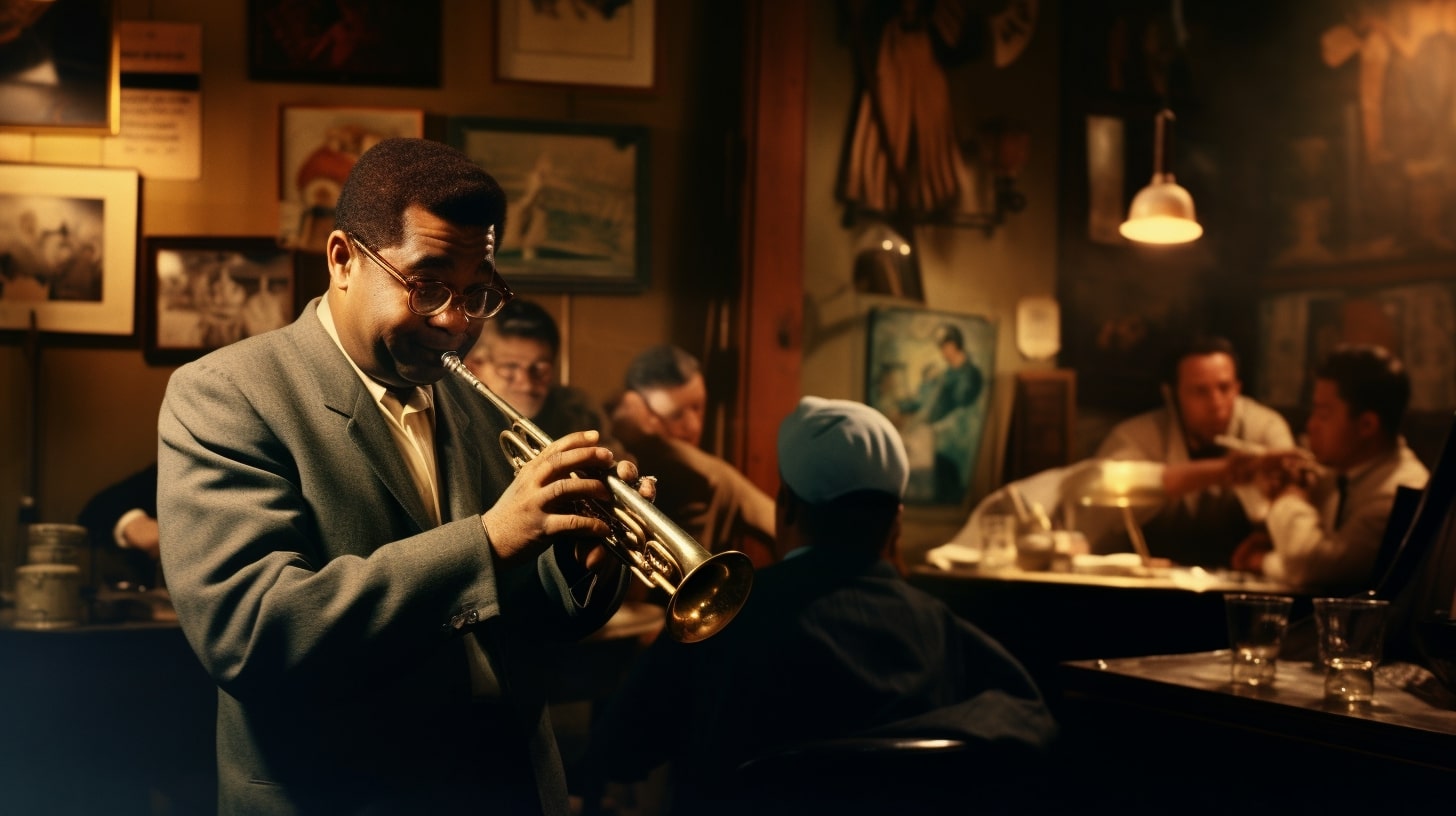John Birks “Dizzy” Gillespie was an American jazz trumpeter, bandleader, composer, educator, and singer who significantly contributed to the development of bebop, a modern jazz style. This exceptional talent set him apart from his contemporaries and earned him a prominent place in the jazz world.
Dizzy Gillespie played this iconic trumpet from the late 1970s to the early 1980s, forever associating him with this one-of-a-kind musical instrument.
Contents
Dizzy Gillespie’s Early Life and Career
Growing Up in Cheraw, South Carolina
Dizzy Gillespie, born John Birks Gillespie on October 21, 1917, was raised in Cheraw, South Carolina. He was the youngest of nine children in a family with a musical background — his father was a local bandleader. Gillespie became interested in music at a young age, learning to play the piano when he was just four years old.
Laurinburg Institute and First Musical Experiences
Gillespie attended the Laurinburg Institute in North Carolina, where he continued to develop his musical skills. By the age of twelve, he had taught himself how to play the trombone and trumpet, laying the foundation for a remarkable career in jazz.
Performing with Frank Fairfax Orchestra, Teddy Hill, and Earl Hines
At the age of 17, Dizzy Gillespie began his professional music career, joining the Frank Fairfax Orchestra in Philadelphia. This experience gave him valuable exposure to other musicians and styles, helping shape his unique sound.
After performing with the Fairfax Orchestra, Gillespie joined two other prominent bands: Teddy Hill’s and Earl Hines’. His time with these groups allowed Gillespie to further refine his skills, develop his signature bebop style, and create lasting connections with other influential jazz musicians.
As Gillespie’s career progressed, he became known for his innovative approach to trumpet playing, ultimately becoming one of the most iconic figures in the bebop movement.
Gillespie’s Instruments and Style
One of the most distinctive aspects of Gillespie’s long and storied career was his unique choice of trumpet, specifically his signature “bent” trumpet. The unusual design of this custom-made “Silver Flair” trumpet offered a striking visual element and showcased the musician’s individuality and creativity.
Bent Trumpet
Dizzy Gillespie, an American jazz trumpeter, was known for playing a unique bent trumpet. Gillespie’s custom-made “Silver Flair” trumpet had an upward tilt, which became one of his trademarks. This distinctive design was not only visually striking but also allowed him to produce a singular sound that set him apart from other jazz trumpeters.
Rise to Virtuoso Status
Born as John Birks Gillespie in 1917, he grew up to become a virtuoso in the world of jazz music. Dizzy learned to play various musical instruments, but it was the trumpet that brought him recognition and fame. The virtuosic style of Roy Eldridge heavily influenced Gillespie.
As a bandleader, often collaborating with saxophonist Charlie Parker, Gillespie developed the musical genre known as “bebop.” Bebop was a reaction to swing and was characterized by dissonant harmonies and polyrhythms. Dizzy’s talent as an improviser and his technical prowess on the trumpet helped him stand out as a seminal figure in the bebop movement.
Throughout his career, Gillespie experimented with various trumpets. However, his custom-made bent “Silver Flair” trumpet remained his most iconic instrument. Dizzy played this trumpet from the late 1970s to the early 1980s.
To sum up, Dizzy Gillespie’s rise to virtuoso status can be attributed to his mastery of the trumpet, innovative bent trumpet design, and his groundbreaking contributions to the bebop genre of jazz music.
Collaborations and Impact on Jazz
Bebop Movement
Dizzy Gillespie played a pivotal role in developing the bebop movement. Alongside other notable musicians like Charlie Parker, Thelonious Monk, and Kenny Clarke, Gillespie added layers of harmonic and rhythmic complexity to jazz, elevating it from its traditional roots. He built on the virtuosic style of Roy Eldridge, experimenting with improvisation and collaborating with fellow bebop pioneers.
Afro-Cuban Jazz
Gillespie’s interest in Afro-Cuban music began while playing in Cab Calloway’s Big Band at the Cotton Club in Harlem. He met a Cuban-American trumpeter and became intrigued by the idea of fusing Afro-Cuban elements with jazz.
His music blended standard jazz instrumentation with Afro-Latin elements such as bongos and claves. In the 1940s, Gillespie’s band featured Chano Pozo, a percussionist from Cuba, sparking interest in the Afro-Cuban jazz style. This innovation broadened the scope of jazz, incorporating world music influences and creating a richer, more diverse sound.
Big Band Era
Dizzy Gillespie’s impact on jazz extended to the Big Band era, where he played with notable musicians such as Coleman Hawkins, Milt Jackson, Clifford Brown, Lee Morgan, Woody Herman, Louis Armstrong, Lionel Hampton, Jonah Jones, and Don Byas.
Gillespie’s work with these legends significantly contributed to jazz’s evolution, pushing the boundaries and exploring new directions. During this time, Gillespie also led his own small groups and recorded with numerous labels, further cementing his status as an integral figure in jazz history.
Signature Songs and Compositions
A Night in Tunisia
A Night in Tunisia is one of Dizzy Gillespie’s most famous compositions, created in the early 1940s. This masterpiece blends bebop and Afro-Cuban rhythms, showcasing Gillespie’s talent in incorporating various musical styles. The catchy melody and unique harmonic structure make it a popular choice among jazz musicians and enthusiasts alike.
Salt Peanuts
Salt Peanuts is another well-known composition by Dizzy Gillespie, which he co-wrote with drummer Kenny Clarke. This playful, energetic tune features a call-and-response melody over a fast bebop rhythm. It quickly became a signature piece for Gillespie and his bands, engaging both the musicians and the audience with its infectious tempo and quirky lyrics.
Manteca
Manteca, composed by Dizzy Gillespie, Chano Pozo, and Gil Fuller, is a landmark in the fusion of Afro-Cuban rhythms and jazz. This groundbreaking piece was written in 1947 when Gillespie was working closely with the legendary Cuban percussionist Chano Pozo.
Most importantly, Manteca’s driving rhythms, powerful brass section, and intricate percussion arrangements have made it an enduring staple in the jazz repertoire.
Groovin’ High
Groovin’ High is another notable composition by Dizzy Gillespie, composed in 1945. This bebop classic showcases Gillespie’s virtuosic trumpet playing and his innovative approach to harmony and rhythm.
The tune features a fast-paced melody and intricate chord progressions, making it a challenging but rewarding piece for musicians to perform. Groovin’ High remains a favorite among jazz enthusiasts and is often included in Gillespie’s tribute concerts and recordings.
Mentorship and Legacy
Influence on Miles Davis and Clifford Brown
Dizzy Gillespie was an instrumental figure in the development of bebop. His innovative approach to his instrument and his harmonic and rhythmic complexity reshaped the genre. Gillespie’s style and work greatly influenced future generations of jazz musicians, including trumpeters Miles Davis and Clifford Brown.
Davis, known for his exploratory and transformative nature, was deeply inspired by Gillespie’s virtuosic trumpet playing and contributions to bebop. Similarly, Clifford Brown, who emerged as one of the leading trumpet players in the 1950s, often cited Gillespie as one of his primary influences.
Jon Faddis and Arturo Sandoval
Gillespie’s impact also reached beyond bebop and extended to younger musicians like Jon Faddis and Arturo Sandoval. Faddis, an exceptional trumpeter with a remarkable range, was mentored by Gillespie from a young age.
He quickly became one of Gillespie’s most notable protégés, embracing Gillespie’s approach to bebop and bebop-infused styles. Additionally, Cuban musician Arturo Sandoval, famous for his technical skill and sleek trumpet playing, was significantly influenced by Gillespie.
Their friendship resulted in Sandoval defecting to the United States, where Gillespie played an essential role in launching Sandoval’s successful career as a jazz performer and composer.
Visual Trademark and Cultural Impact
Dizzy Gillespie not only left a lasting impact on the sound of jazz but also on its visual culture. His upturned trumpet, with the bell tilting upwards at a 45-degree angle, became an easily recognizable visual trademark today. This unusual instrument shape was due to an accident in 1953 when someone sat on his trumpet. Gillespie noticed the altered sound and continued playing with an upturned bell for the rest of his career. This unique design is now on display at the Smithsonian National Museum of American History.
Dizzy Gillespie was awarded the Kennedy Center Honors Award for his numerous contributions and influence on jazz music. Through his innovative playing style, unforgettable visual trademarks such as his unique trumpet and distinctive spectacles, and the mentorship of notable figures like Miles Davis, Clifford Brown, Jon Faddis, and Arturo Sandoval, Gillespie has earned an indisputable place in both American history and the global jazz landscape.






